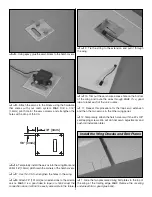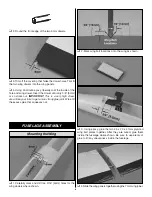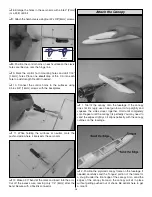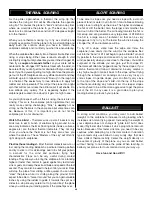
There are several types of mixing the Spirit Elite ARF can
take advantage of if you have a “computer radio”.
Launch Camber:
Lowering the flaps and ailerons during the
launch will produce a steeper climb, giving you better
altitude. A good place to start is about 15 degrees of flap
and 5 degrees of aileron drop (the flaps will drop about three
times more than the ailerons). This automatically puts some
washout in the wing which adds stability for arrow straight
launches. If you don’t have a switch for launch camber, just
use the flaps for launch.
Crow:
This is used to lose altitude quickly and to control your
glide for spot landings. This mixing is tied to the flap stick
(throttle)and allows the ailerons to come up as the flaps drop.
Be sure to use plenty of aileron differential when using
CROW mixing because the ailerons become less effective at
very high angles of deflection. Also use maximum rudder
coupling at full CROW. If you don’t have CROW capabilities
just use flaps and make sure you have full rudder throw when
the flaps start coming down. It is a good idea to
get lined up
on the spot
before dropping the flaps very much because
the rudder will become sluggish with the flaps down at slow
speeds. Note: You will need to mix in a little down elevator
with the flaps to keep the plane tracking straight.
Aileron/Rudder Coupling -
This is used to allow the
sailplane to make efficient, non-slipping, non-skidding turns.
You will need to experiment to find the proper amount of
throw required to do this but 1" [25mm] of rudder throw at full
aileron is probably a good place to start.
Elevator/Camber Coupling -
This is a neat type of mixing
that allows the TE (ailerons and flaps) to respond to the
elevator. When properly set up, this can be very useful when
floating around in light air or when trying to thermal very
tightly. This mixing can change the flying characteristics of
the plane so start off small and get used it. A good place to
start would be 1/8" [3mm] of TE drop at full up elevator.
Controlling the Wing Trailing Edge (Camber):
The wing
camber is usually controlled by a 3-position switch. The
traditional way of setting this switch is to have: the middle
position set to neutral camber, one direction for reflex (the
entire TE raises about 1/16" [1.5mm]) and the other direction
for positive camber (the entire TE drops about 3/32"
[2.5mm]). This way of programming the switch is great for
good thermal-days or days with a lot of wind where you
might need the reflex capability for zooming up wind. The
other way we set this switch is to have the “back” position for
neutral camber, the middle position for a slight amount of
positive camber [1/32" [1mm] - 1/16" [2mm]) and the forward
position for more positive camber [3/32" [2.5mm] - 1/8"
[3mm]). The middle position can be used once good air is
located or when trying to gain a few extra seconds of air
time. Normally the L/D will not be as great as neutral camber
but the sailplane will float better. The forward position is
when the sailplane is low and encounters lift, don’t panic,
just hit the switch. The SPIRIT ELITE will really slow up and
will thermal “on a dime”. This set-up is great for duration type
flying without a lot of wind.
Thermals are a natural phenomenon that happen outside,
by the millions, every single day of the year. Thermals are
responsible for many things including forming several types
of clouds, creating breezes and distributing plant seeds and
pollen. If you have ever seen a dust devil (which is nothing
more than a thermal that has picked up dust), you have seen
a thermal in action. Their swirling action is very similar to that
of a tornado but much gentler. Most thermals have updrafts
rising 200-700 feet per minute but have been known to
produce updrafts of over 5,000 feet per minute These strong
thermals can rip a plane apart or carry the plane out of sight
before the pilot can get out of the updraft.
Thermals are formed by the uneven heating of the earth and
buildings, etc. by the sun. The darker colored surfaces
absorb heat faster than the lighter colors which reflect a
great deal of the sun’s energy back into space. These darker
areas (plowed fields, asphalt parking lots, tar roofs, etc.) get
warmer than the lighter areas (lakes, grassy fields, forests,
etc.). This causes the air above the darker areas to be
warmer than the air over the lighter areas and the more
buoyant warm air rises as the cooler, denser air forces its
way underneath the warmer air. As this warm air is forced
upward it contacts the cooler air of the higher altitudes and
this larger temperature difference makes the thermal rise
quicker. The thermal is gradually cooled by the surrounding
cooler air and its strength diminishes. Eventually the thermal
stops rising and any moisture contained in the once warm
air condenses and forms a puffy cumulus cloud. These
clouds, which mark the tops of thermals, are usually
between 2000 and 5000 feet high.
TYPICAL THERMAL
Wind causes thermal
to drift downwind.
WIND DIRECTION
FACTS ABOUT THERMALS
ADVANCED FEATURES
21



































